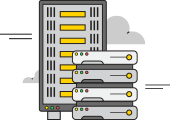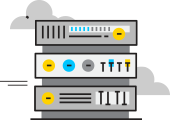An application server is a critical component in modern web architecture that handles the processing of dynamic content and the execution of various applications for web-based services. It acts as an intermediary between the user’s web browser and the back-end database, ensuring smooth communication and delivering dynamic content to users. In the context of OneProxy (oneproxy.pro), the application server plays a vital role in providing efficient and secure proxy services to its clients.
The History of the Origin of Application Server and the First Mention of It
The concept of the application server has evolved over time in response to the growing complexity of web applications and the need to manage concurrent user requests effectively. The term “application server” was first mentioned in the late 1990s when the internet saw an explosion of web-based applications and e-commerce websites.
In the early days of the internet, websites were primarily static, consisting of simple HTML files that were sent directly to users’ browsers. However, as businesses demanded more dynamic and interactive websites, a new architecture emerged, separating the presentation layer (front-end) from the business logic and data storage layer (back-end). This separation paved the way for the application server to handle the application logic and deliver dynamic content to users.
Detailed Information about Application Server: Expanding the Topic
The application server is a crucial component of the three-tier architecture used in modern web development, consisting of:
-
Presentation Layer (Client-side): This layer is responsible for rendering the user interface and handling user interactions. It includes web browsers and various client-side technologies like HTML, CSS, and JavaScript.
-
Application Layer (Middle-tier/Application Server): The application server sits in the middle, between the front-end and the back-end. It processes business logic, performs data manipulation, and communicates with the back-end databases or other services.
-
Data Layer (Back-end): This layer is responsible for data storage and retrieval. It typically includes databases and data storage systems.
The primary functions of the application server include:
- Processing and executing user requests from the front-end.
- Managing application logic, including data validation, calculations, and business rules.
- Accessing and interacting with the back-end data storage systems.
- Generating dynamic content, such as personalized web pages, based on user input or preferences.
- Enforcing security measures, such as authentication and access control.
The Internal Structure of the Application Server: How It Works
The internal structure of an application server can vary based on the specific technology stack and programming languages used. However, the core functionality remains consistent across different implementations.
Typically, an application server includes the following components:
-
Web Container: Also known as a Servlet Container, this component manages the execution of web applications based on the Java Servlet API or other web standards. It handles HTTP requests and responses and manages the lifecycle of web components (e.g., servlets and JavaServer Pages).
-
EJB Container: If the application server supports Enterprise JavaBeans (EJB), this container manages the execution of EJB components. EJBs are used for complex business logic and transactions in enterprise applications.
-
Connection Pooling: To improve performance and manage resources efficiently, application servers often implement connection pooling, which reuses database connections rather than creating a new one for each request.
-
Security Management: The application server provides security features like authentication, authorization, and encryption to safeguard sensitive data and ensure secure communication.
-
Clustering and Load Balancing: For high availability and scalability, some application servers support clustering and load balancing, distributing user requests across multiple server instances.
Analysis of the Key Features of Application Server
The application server offers several key features that make it essential for modern web development and the delivery of dynamic content:
-
Scalability: Application servers can handle a large number of concurrent user requests, making them suitable for websites with high traffic.
-
Security: By providing built-in security mechanisms, the application server helps protect web applications from various threats, such as cross-site scripting (XSS) and SQL injection.
-
Resource Management: Application servers efficiently manage system resources and database connections, optimizing performance and reducing bottlenecks.
-
Middleware Integration: Application servers can act as a middleware layer, integrating various software components and services, facilitating communication between different parts of the application.
-
Platform Independence: Many application servers are designed to be platform-independent, allowing developers to write applications in one programming language and deploy them on different platforms.
Types of Application Server
Application servers come in various types, each designed to cater to specific needs and technologies. Here are some common types of application servers:
| Type | Description |
|---|---|
| Java EE Application Server | Designed to support Java Enterprise Edition (Java EE) applications, leveraging Java Servlets, JavaServer Pages (JSP), and Enterprise JavaBeans (EJB). Widely used for enterprise-level applications. |
| .NET Application Server | Developed to host applications built on the Microsoft .NET Framework. Supports ASP.NET web applications and manages .NET components. |
| Node.js Application Server | Optimized for handling applications developed using Node.js, a popular JavaScript runtime. Suited for real-time, high-concurrency applications. |
| PHP Application Server | Tailored for PHP-based applications, handling PHP scripts and delivering dynamic web content. Commonly used for content management systems and web applications. |
Ways to Use Application Server, Problems, and Solutions
Application servers are used in various scenarios to deliver dynamic and interactive web experiences. Some common use cases include:
-
Web Application Hosting: Application servers are used to host and manage web applications, such as e-commerce platforms, social networks, and online banking systems.
-
Enterprise Applications: Large organizations deploy application servers to handle complex business processes, workflow automation, and data management.
-
API Management: Application servers play a crucial role in API management, facilitating communication between different applications and services.
-
Mobile App Backend: For mobile app development, application servers serve as the backend, handling data synchronization, user authentication, and push notifications.
-
Microservices Architecture: In a microservices-based architecture, application servers are used to manage individual microservices and orchestrate their communication.
Problems that can arise when using application servers include:
-
Performance Bottlenecks: High traffic can lead to performance issues if the application server is not appropriately configured or lacks sufficient resources.
-
Security Vulnerabilities: Poorly implemented security measures can result in data breaches and unauthorized access to sensitive information.
-
Application Crashes: Bugs or coding errors in the application can lead to unexpected crashes and downtime.
Solutions to these problems involve:
-
Load Balancing: Distributing incoming traffic across multiple application server instances to avoid overloading a single server.
-
Caching: Implementing caching mechanisms to reduce the need for repetitive data processing and improve response times.
-
Regular Updates and Security Patches: Keeping the application server software up to date with the latest security patches and bug fixes.
Main Characteristics and Other Comparisons with Similar Terms
Let’s compare the application server with some related terms in web development:
| Term | Description |
|---|---|
| Web Server | Handles HTTP requests and responds with static content (HTML, CSS, images). It lacks application processing capabilities. |
| Database Server | Manages data storage and retrieval, providing a persistent storage solution for the application. |
| Proxy Server | Acts as an intermediary between clients and servers, forwarding requests and handling security and anonymity for users. |
| Load Balancer | Distributes incoming network traffic across multiple servers to prevent overloading and improve performance. |
| Reverse Proxy | Sits between clients and servers, handling requests on behalf of servers and providing additional security features. |
The application server stands out by offering dynamic content generation, application logic processing, and middleware integration capabilities that other servers lack.
Perspectives and Technologies of the Future Related to Application Server
As technology advances, the role of the application server will continue to evolve. Some future perspectives and technologies include:
-
Serverless Architecture: The rise of serverless computing may change how applications are hosted, reducing the need for traditional application servers. Serverless platforms abstract away the server management, allowing developers to focus solely on code execution.
-
Containerization and Microservices: The use of containerized applications and microservices architecture will impact how application servers are deployed and managed. Containers offer scalability and flexibility, allowing applications to be easily moved across environments.
-
Edge Computing: With the growth of edge computing, application servers may move closer to end-users, reducing latency and improving performance for distributed applications.
-
AI and Machine Learning Integration: Application servers may incorporate AI and machine learning capabilities to optimize resource allocation, improve security, and enhance user experiences.
How Proxy Servers Can Be Used or Associated with Application Server
Proxy servers and application servers can be used together to enhance security, performance, and user experience. Proxy servers act as intermediaries between clients and application servers, handling incoming requests and forwarding them to the appropriate destination. This combination can bring several benefits:
-
Load Distribution: Proxy servers can balance the incoming traffic across multiple application server instances, ensuring optimal resource utilization and improved performance.
-
Caching: Proxy servers can cache frequently requested content, reducing the load on application servers and speeding up response times.
-
Security and Anonymity: Proxy servers provide an additional layer of security by hiding the application server’s actual IP address and protecting it from direct exposure to the internet.
-
Content Filtering: Proxy servers can filter and block certain content or websites, adding an extra layer of control and security to the application.
-
Geo-blocking: Proxy servers can enforce geographic restrictions, allowing application servers to serve different content to users based on their location.
Related Links
For more information about application servers, web development, and proxy servers, you can refer to the following resources:
- Java EE Documentation
- Microsoft .NET Documentation
- Node.js Documentation
- PHP Documentation
- Nginx Documentation
By exploring these resources, readers can gain a deeper understanding of application servers and how they contribute to the seamless functioning of web applications and services.




